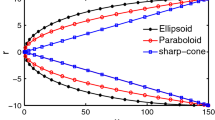Abstract
The effects of different axisymmetric forebody shapes have been studied on the non-axisymmetric (helical) global modes of the boundary layer developed on a circular cylinder. Sharp cone, ellipsoid and paraboloid shapes have been considered with the fineness ratio (FR) of 2.5, 5.0 and 7.5. The base flow is in line with the cylinder’s axis at the inflow boundary, and hence the base flow is axisymmetric. The boundary layer has developed from the tip of the forebody where a highly favourable pressure gradient exists, and it depends on the sharp edge of the forebody’s geometric shape. However, the pressure gradient then remains constant on the cylindrical surface of the main body. Thus, the boundary layer developed on the forebody and main body (cylinder) is non-parallel, non-similar and axisymmetric. The governing equations for the stability analysis of the small disturbances have been derived in the cylindrical polar coordinates. The spectral collocation method with Chebyshev polynomials has been used to discretise the stability equations. An eigenvalue problem has been formulated from the discretised stability equations along with the appropriate boundary conditions. The numerical solution of the eigenvalue problem was done using Arnoldi’s iterative algorithm. The global temporal modes have been computed for helical modes \(N = 1\), 2, 3, 4 and 5 for Reynolds number \(Re = 2000\), 4000 and 10000. The spatial and temporal structures of the least stable global modes have been studied for different Reynolds numbers and helical modes. The global modes with ellipsoid were found the least stable while that of the sharp cone were found the most stable.













Similar content being viewed by others
References
J S Parsons and R E Goodson, Technical report H, Automatic control center, School of Mechanical Engineering (Purdue University, 1972)
V Narayanan and R Govindarajan, Pramana – J. Phys. 64(3), 323 (2005)
M Casarella, T C Shen and B E Bowers, Ship Aoustic Dept. R & D Report 77 (1977)
R L James, B H Navran and R A Rozenddal, NASA CR-166051 (1984)
B J Holmes, C J Obara and L P Yip, NASA TP-2256 (1984)
B H Carmichael, Underwater missile propulsion (Compass Publications, 1966)
V Theofilis, Prog. Aerosp. Sci. 39, 249 (2003)
F Alizard and J C Robinet, Phys. Fluid 19, 114105 (2007)
E Akervik, U Ehrenstein, F Gallaire and D S Henningson, Eur. J. Mech. B/Fluids 27, 501 (2008)
G N V Rao, J. Appl. Math. Phys. 25, 63 (1974)
O R Tutty and W G Price, Phys. Fluid 14, 628 (2002)
R Bhoraniya and V Narayanan, J. Phys.: Conf. Ser. 822, 012018 (2017)
R Bhoraniya and V Narayanan, Phys. Rev. Fluids 2, 063901 (2017)
R Bhoraniya and V Narayanan, Theor. Comput. Fluid Dyn. 32, 425 (2018)
R Bhoraniya and V Narayanan, Pramana – J. Phys. 39(5), 93 (2019)
U Ehrenstein and F Gallaire, J. Fluid Mech. 536, 209 (2005)
G Swaminathan, K Shau, A Sameen and R Govindarajan, Theor. Compt. Fluid Dyn. 25, 53 (2011)
R Bhoraniya and V Narayanan, Fluid Dyn. 54(5), 93 (2019)
M Gaster, J. Fluid Mech. 22, 433 (1965)
A Michalke, J. Fluid Mech. 23, 521 (1965)
C K W Tam, J. Fluid Mech. 89, 357 (1978)
J M Chomaz, P Huerre and L G Redekopp, Proc. Symp. Turbul. Shear flows, 6th, Toulouse, Fr. 3.2, 1 (1987)
J M Chomaz, P Huerre and L G Redekopp, Phys. Rev. Lett. 60, 25 (1988)
R T Pierrehumbert, J. Atmos. Sci. 62, 2141 (1984)
W Koch, J. Sound Vib. 99, 53 (1985)
P A Monkewitz, D W Bechert, B Barsikow and B Lehmann, J. Fluid Mech. 31, 999 (1988)
P Huerre and P A Monkwwitz, Annu. Rev. Fluid Mech. 22, 473 (1990)
R S Lin and M R Malik, J. Fluid Mech. 311, 239 (1996)
R S Lin and M R Malik, J. Fluid Mech. 333, 125 (1997)
V Theofilis, P W Duck and J Owen, J. Fluid Mech. 505, 249 (2004)
V Theofilis, Theor. Comput. Fluid Dyn. 31, 623 (2017)
M R Malik, J. Comput. Phys. 86(2), 372 (1990)
Author information
Authors and Affiliations
Corresponding author
Rights and permissions
About this article
Cite this article
Bhoraniya, R., Narayanan, V. Global stability analysis of the axisymmetric boundary layer: Effect of axisymmetric forebody shapes on the helical global modes. Pramana - J Phys 95, 109 (2021). https://doi.org/10.1007/s12043-021-02147-4
Received:
Revised:
Accepted:
Published:
DOI: https://doi.org/10.1007/s12043-021-02147-4




